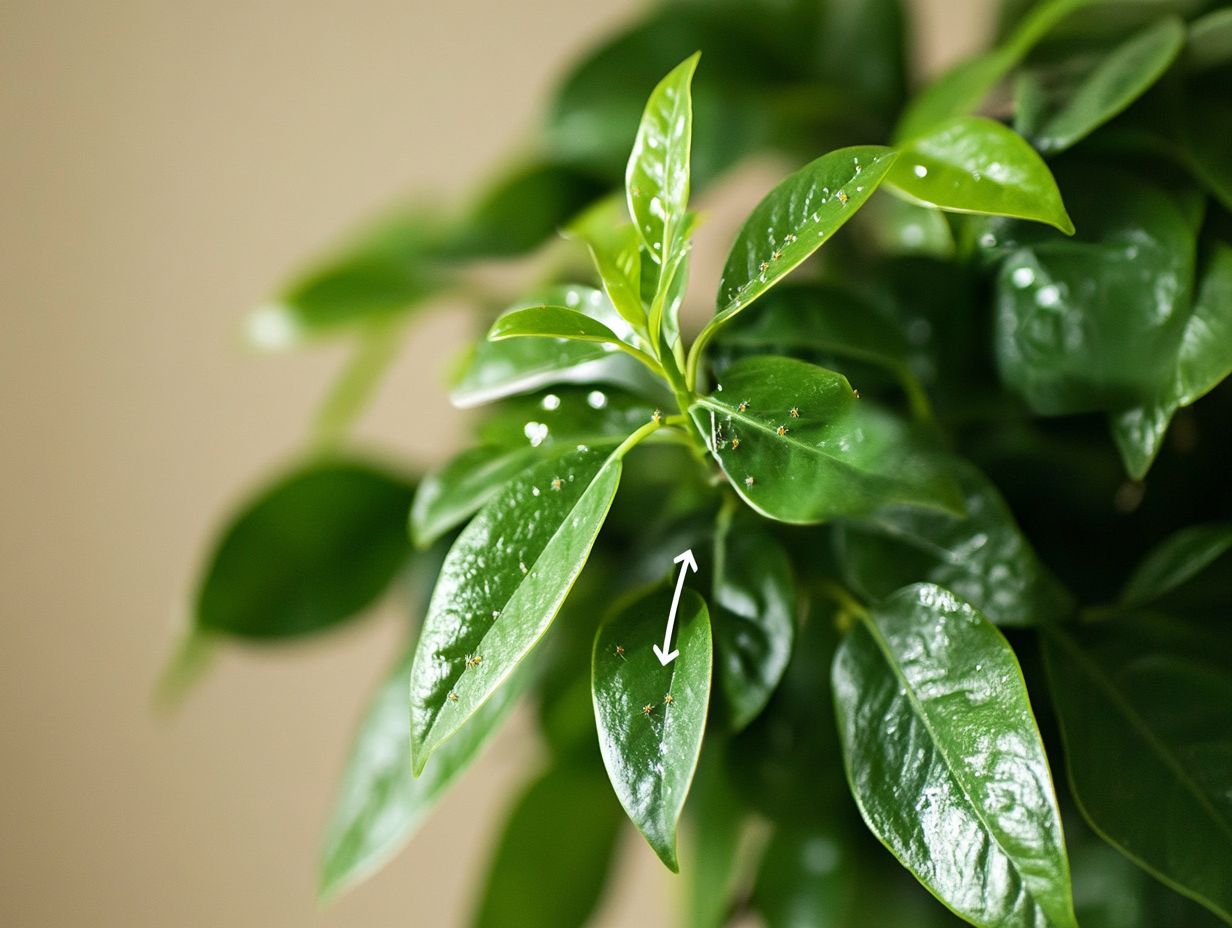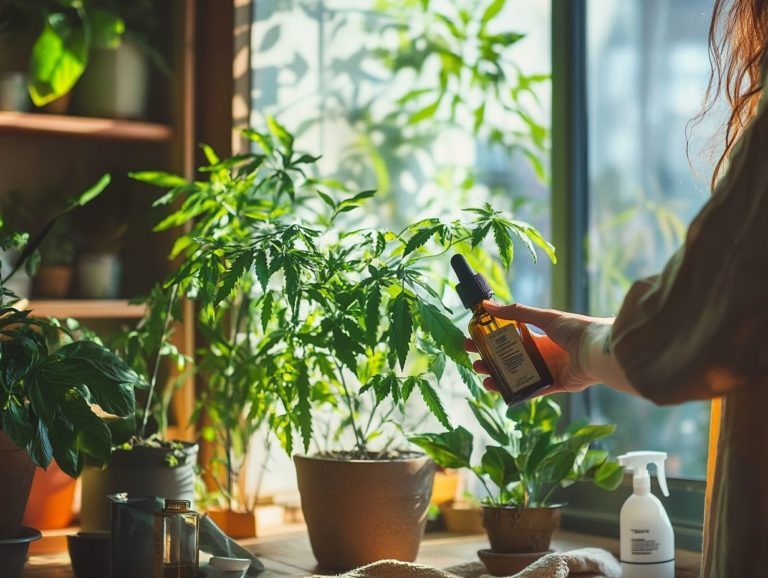How to Identify Common Indoor Plant Pests
Indoor plants can infuse your space with life and vibrancy, but they often attract unwelcome guests: pests. Understanding these indoor plant pests and how to identify them is essential for maintaining a healthy environment for your plants.
This article covers the most common types of pests, the telltale signs of an infestation, and effective prevention methods. It will also spotlight natural and non-toxic solutions to help your plants thrive without harmful chemicals. Immerse yourself in this knowledge to protect your green companions!
Contents
- Key Takeaways:
- Common Types of Indoor Plant Pests
- Signs of an Infestation
- Preventing Indoor Plant Pests
- Treatment and Control
- Natural and Non-Toxic Solutions
- Frequently Asked Questions
- What are some common signs of indoor plant pests?
- How can I identify the type of pest infesting my indoor plant?
- What are some natural remedies for getting rid of indoor plant pests?
- What should I do if I find indoor plant pests on my new plant?
- Can indoor plant pests harm humans or pets?
- How can I prevent indoor plant pests from infesting my plants?
Key Takeaways:

- Regularly inspect your indoor plants for signs of pest infestation, such as visual cues and damage, to catch and treat the problem early.
- Preventing indoor plant pests is key to avoiding infestations. Keep your plants clean, provide adequate drainage, and use natural, non-toxic solutions.
- When treating and controlling indoor plant pests, consider methods like manual removal, insecticidal soap, and beneficial insects for eco-friendly pest control.
What are Indoor Plant Pests?
Indoor plant pests include various insect species that can jeopardize the vitality of your cherished houseplants. These infestations can hinder growth and compromise overall health. Understanding these pests is crucial for cultivating a thriving indoor garden and managing them effectively with practical strategies.
Identifying signs of an infestation such as stunted growth, yellowing leaves, and sticky residue is vital for prompt action. To protect your plants effectively, learn how to keep your indoor plants pest-free. The repercussions can be significant, resulting in weakened plants that struggle to flourish.
Management strategies combine different approaches, including cultural practices, biological controls, and, when necessary, targeted chemical applications. This holistic method mitigates pest impacts while nurturing a healthier indoor ecosystem.
By keeping a vigilant eye on pest populations and fostering good insects, you can restore balance and ensure your houseplants remain vibrant and resilient.
Common Types of Indoor Plant Pests
You ll encounter several common indoor plant pests such as mealybugs, scale insects, aphids, and spider mites. Each pest poses unique challenges that require tailored pest control strategies to manage their impact effectively on your indoor greenery.
Identification and Characteristics
Identifying indoor plant pests involves recognizing the distinct characteristics of various insect species. For instance, look for the cottony appearance of mealybugs, the hard shell of scale insects, the soft-bodied aphids, and the telltale webbing from spider mites. This knowledge is crucial for effective plant inspection and pest management.
Understanding the life cycles of these pests enhances your ability to intervene timely. For example, mealybugs reproduce quickly, making early detection essential. You’ll often spot them as white, cottony masses that cling to leaves or stems. Scale insects can be identified by their dome-like shapes and tend to remain stationary, making them easy to overlook. If you’re dealing with aphids, check out our guide on how to remove aphids from indoor plants for effective solutions.
Aphids typically exhibit a green or black hue with pear-shaped bodies and often gather in clusters on new growth. Spider mites are known for their fine webbing, which can wreak havoc if not managed swiftly as they prefer the underside of leaves. Regularly monitoring your plants for these signs allows you to take proactive steps to maintain a healthy indoor garden and implement techniques for preventing pest infestations in indoor plants.
Signs of an Infestation

If you notice signs of an infestation, pay attention to visual cues like wilting leaves, discolored spots, sticky honeydew deposits, and the presence of sooty mold, which indicates plant diseases. Each of these indicators points to pest damage and signals an urgent need for action to protect your beloved plants.
Act now to keep your plants safe!
Visual Cues and Damage
Visual cues from pest damage can reveal themselves as yellowing leaves, webbing, or distorted growth in your plants. These signs serve as essential indicators for assessing the overall health of your indoor garden and understanding pest populations.
These signs often indicate specific pests like spider mites, aphids, or mealybugs, each bringing unique symptoms that can hinder your plants’ vitality. For instance, fine webbing on leaves is a telltale sign of spider mites, indicating a heavy infestation. To address issues related to soil health and pest management, refer to this guide on how to identify and treat soil of indoor plants. Aphids might cluster on new growth, greedily sucking sap and causing wilting.
Regular monitoring is crucial for effective plant care. By consistently checking for pests and implementing protective measures, you can cultivate a thriving indoor ecosystem and promote optimal growth in your cherished plants. Understanding indoor plant pest resistance can also enhance your efforts in maintaining their health.
Preventing Indoor Plant Pests
To prevent indoor plant pests, embrace effective gardening habits, implement organic gardening techniques, and commit to environmentally sustainable practices. These strategies discourage pest infestations and promote the overall health of your indoor gardening setup.
Tips for Avoiding Infestations
Implementing essential tips to avoid infestations can significantly enhance your pest prevention efforts. Regularly inspecting your plants and maintaining their health will foster a thriving indoor gardening environment.
By adopting a proactive approach, you can effectively minimize risks and create a protective barrier against common pests. Early signs of trouble, such as discolored leaves or unusual spots, are key indicators that something is amiss. To address specific issues, such as recognizing scale insects on indoor plants, it’s important to stay vigilant.
Ensure proper watering and maintain a balanced nutrient level in the soil to strengthen your plants’ resilience. Keeping your growing area clean and clutter-free will also deter unwanted visitors.
Utilizing natural pest control methods, such as introducing beneficial insects and applying organic pesticides when necessary, will further safeguard your plants. It’s important to be aware of the signs your indoor plant has pests. These straightforward yet effective measures are instrumental in cultivating a successful and pest-resistant indoor garden.
Treatment and Control

Effectively treating and controlling indoor plant pests requires a strategic approach. This includes using soap that kills insects, introducing beneficial insects, and understanding the pest life cycle. Mastering these elements allows you to manage and eliminate infestations, ensuring your plants thrive in a healthy environment.
Effective Methods for Eliminating Pests
Eliminating pests involves various pest control techniques. One effective method is using soap that kills insects, which helps tackle outbreaks while promoting the health of your plants.
Neem oil is a valuable ally in pest control. It acts as an insect repellent and a growth regulator, supporting your garden’s overall vitality.
Another strategy is introducing beneficial insects like ladybugs and lacewings, which naturally prey on harmful pests. This reduces their populations without resorting to harsh chemicals.
Traps can also effectively capture unwanted visitors and prevent their spread in your pest management efforts.
By integrating these methods, you create a balanced approach to pest treatment that fosters a healthier ecosystem for your plants to flourish.
Natural and Non-Toxic Solutions
Explore natural and non-toxic solutions for indoor plant pest control that safeguard your greenery and protect the environment. Consider eco-friendly methods like introducing beneficial insects or utilizing a natural bacteria that controls pests.
These approaches promote the health of your plants without relying on harmful chemicals, allowing you to cultivate a thriving indoor oasis while implementing pest remedies to tackle the top 10 pests that affect indoor plants.
Eco-Friendly Pest Control Options
Eco-friendly pest control options offer you effective solutions for managing indoor plant pests while supporting gardening that is good for the environment. By using natural techniques and beneficial insects, you can maintain the health of your plants without compromising the environment.
These methods tackle pest problems and contribute to a healthier ecosystem for both your plants and their surroundings. For example, introducing predatory insects like ladybugs can drastically cut down aphid populations, all without the need for harsh chemicals. To effectively manage these pests, understanding the life cycle of common indoor plant pests can be beneficial. Try making your own remedies like insecticidal soap and garlic sprays! These act as powerful deterrents against unwanted pests.
Implementing companion planting strategies, where certain plants naturally repel pests, is another sustainable method that enhances plant resilience. By weaving these eco-friendly strategies into your gardening routine, you can cultivate vibrant indoor greenery while minimizing your ecological footprint.
Frequently Asked Questions

What are some common signs of indoor plant pests?
Some common signs of indoor plant pests include yellowing or wilting of leaves, sticky residue on leaves or stems, visible insects on the plant, and small holes on leaves or stems. Common pests like mealybugs and aphids often leave behind honeydew, a sticky substance that can attract other pests. Effective pest management strategies can reduce pest populations.
How can I identify the type of pest infesting my indoor plant?
You can identify the type of pest by closely examining the plant and the insects. Use a magnifying glass for a better look and compare the insects to pictures online or in gardening books.
What are some natural remedies for getting rid of indoor plant pests?
Some natural remedies include using insecticidal soap, which is effective against a variety of pests including spider mites and scale insects. You can also introduce beneficial insects, such as green lacewing larvae and mealybug destroyers, to your plant. These natural techniques are part of a method that uses multiple strategies to control pests effectively.
Consider using neem oil, insecticidal soap, or a mixture of water and dish soap. Additionally, you can introduce natural predators, such as ladybugs, to your plant. For more options, check out the top 5 natural remedies for houseplant pests.
What should I do if I find indoor plant pests on my new plant?
If you find pests on a new plant, it’s important to isolate it from other plants and thoroughly inspect it. Gently wash the leaves with water to remove any pests. If the infestation is severe, consider returning the plant or seeking professional help.
Can indoor plant pests harm humans or pets?
Most indoor plant pests do not pose a threat to humans or pets. However, some can cause skin irritation or allergic reactions. Always wash your hands after handling infested plants and keep them out of reach of pets and children.
Act quickly to protect your plants! If you have more questions or want to share your experiences, feel free to reach out!
How can I prevent indoor plant pests from infesting my plants?
Check your plants often for signs of pests. Early detection helps keep them safe.
Keep your plants clean and free of debris. Avoid overwatering to prevent issues.
You can introduce beneficial insects, like ladybugs, which eat harmful pests. Good gardening habits are crucial for protecting your plants over time.






